Canon PowerShot G1X Mark II review
-
-
Written by Gordon Laing
Quality
Canon G1 X II vs Sony RX100 II vs RX100 III
To compare real-life performance at wide angle, I shot this scene with the Canon PowerShot G1 X Mark II, and the Sony Cyber-shot RX100 Mark II and III within a few moments of each other using their base sensitivities and best quality JPEG settings. I tried every aperture setting and selected the sharpest result for the crops below. For comparison here I attempted to match the vertical coverage as closely as the optical zooms allowed.
I tested all three cameras at each of their apertures and found f4 to be a common sweetspot, so that’s what I set each of them to in Aperture Priority. I then shot this scene at their lowest respective sensitivities and noted each camera metered the same exposure, compensating for the slight variances in ISO with equal ones in shutter speed; so what you’re looking at below are identical exposures, with each camera’s default image processing applied to see how their JPEGs compare under best-case scenarios.
The crops as always are taken from the areas marked by the red rectangles in the thumbnail above right and presented here at 100%. The two Sony cameras show the same image area due to the same sensor resolution, but the Canon G1 X II shows a greater area due to its lower sensor resolution. I’ve pictured the crops in columns, from left to right, Sony RX100 Mark II, Sony RX100 Mark III and Canon G1 X Mark II.
Comparing the two Sonys first, I think they’re delivering essentially the same degree of real-life detail and that the only difference between them here is a slight crispness to the newer Mark III. This could be down to the different lens, but I think image processing is also playing an important role here as my RAW comparisons on the next page are closer than the JPEGs here. But either way I think most would agree there’s little to nothing to choose between the RX100 Mark II and Mark III for normal outdoor photography at a mid-to-wide focal length and f4 aperture.
Moving onto the RX100 Mark III versus the Canon G1 X Mark II, there is a visible resolution benefit to the Sony, although perhaps not as much as you’d expect for 20 Megapixels versus 12.8. But if you look at fine horizontal lines in various grills, ledges and fencing, the Sony definitely enjoys an advantage. But remember this is in bright sunlight at their lowest ISOs. The Canon has a bigger sensor and packs less pixels into it, so should enjoy the advantage when it comes to low light, and you can check out my comparison in my Canon G1 X II noise results.
Alternatively head over to my Canon G1 X II RAW quality page to see what happens when you remove each camera’s internal processing from the equation. Or if you’ve seen enough, skip to my Canon G1 X II sample images or final verdict.
Sony Cyber-shot RX100 II JPEG | Sony Cyber-shot RX100 III JPEG | Canon PowerShot G1 X II JPEG | ||
 | 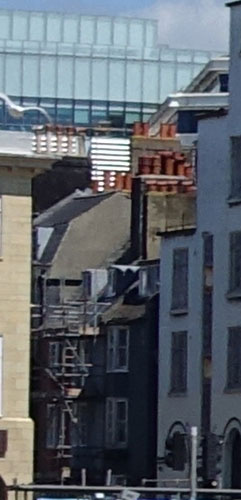 | 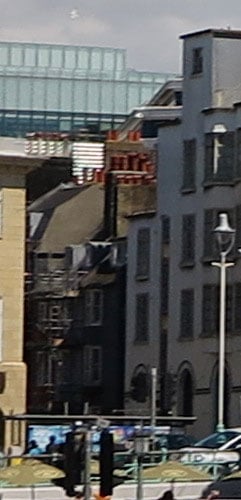 | ||
f4, 160 ISO | f4, 125 ISO | f4, 100 ISO | ||
 |  |  | ||
f4, 160 ISO | f4, 125 ISO | f4, 100 ISO | ||
 | 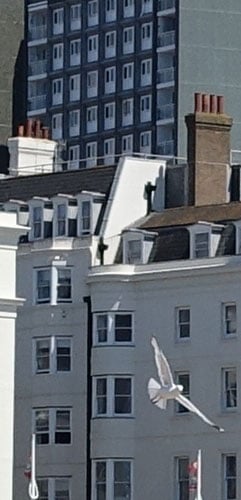 | 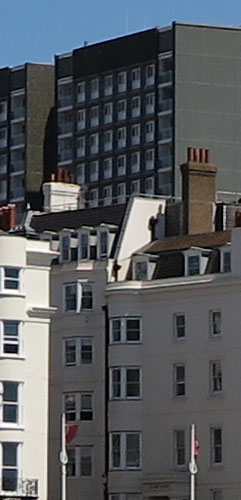 | ||
f4, 160 ISO | f4, 125 ISO | f4, 100 ISO | ||
 |  |  | ||
f4, 160 ISO | f4, 125 ISO | f4, 100 ISO | ||
 | 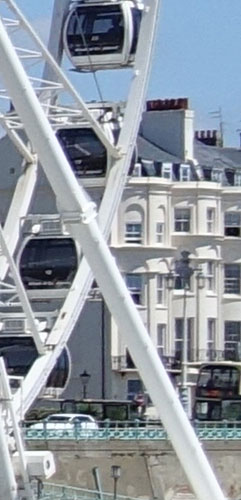 | 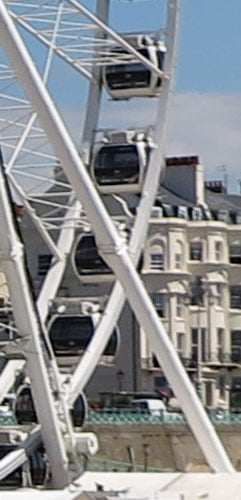 | ||
f4, 160 ISO | f4, 125 ISO | f4, 100 ISO |
Canon G1 X II vs Sony RX100 II vs RX100 III RAW quality
To compare real-life RAW performance at wide angle, I shot this scene with the Canon PowerShot G1 X Mark II, and the Sony Cyber-shot RX100 Mark II and III within a few moments of each other using their base sensitivities and RAW modes. I tried every aperture setting and selected the sharpest result for the crops below. For comparison here I attempted to match the vertical coverage as closely as the optical zooms allowed.
I tested all three cameras at each of their apertures and found f4 to be a common sweetspot, so that’s what I set each of them to in Aperture Priority. I then shot this scene at their lowest respective sensitivities and noted each camera metered the same exposure, compensating for the slight variances in ISO with equal ones in shutter speed; so what you’re looking at below are identical exposures.
On the previous page you saw how each camera applied their own processing defaults. On this page I removed this from the equation and processed each file in Adobe Camera RAW using identical settings: 50 / 0.5 / 36 / 10 for the unsharp mask, 5200K / +11 for the White Balance, all noise reduction turned-off and all lens corrections disabled. The higher than normal degree of sharpening and zero NR brings out all the detail but also any undesirable artefacts, revealing what data you have to work with when processing by hand.
The crops as always are taken from the areas marked by the red rectangles in the thumbnail above right and presented here at 100%. The two Sony cameras show the same image area due to the same sensor resolution, but the Canon G1 X II shows a greater area due to its lower sensor resolution. I’ve pictured the crops in columns, from left to right, Sony RX100 Mark II, Sony RX100 Mark III and Canon G1 X Mark II.
Comparing the two Sonys first, I’d say processing their images using the same settings has resulted in even closer performance. There’s now virtually nothing between the Mark II and Mark III for this particular scene, except for the final row which indicates a slightly softer result in the corner on the older Mark II – so a tiny optical benefit to the Mark III there, but otherwise almost identical performance.
Moving onto the RX100 Mark III versus the Canon G1 X Mark II, I’d once again re-iterate what I said on the previous page that the Sony is recording greater real-life detail than the Canon, thanks of course to its 20 Megapixels versus 12.8; I’d also note that the Canon lens, like the RX100 II, looks a little softer at the extreme edges than the latest Sony. Once again though the benefit of the Canon should hopefully be lower noise at high ISOs and I’ll put that to the test on the next page, my Sony RX100 III noise results.
Just before leaving this page though, I think it’s interesting to compare the RAW results here with the in-camera JPEGs on the previous page. Which do you prefer the look of? For me, it’s the JPEGs and this doesn’t come as any surprise as the manufacturers know the limitations of their own cameras very well, allowing them to maximize the pros and minimize the cons. Of course your mileage may vary when processing RAW files, but unless you want to adjust things like the white balance after the event or retrieve the maximum highlight detail, I’d be more than happy shooting JPEGs with these models. Right now for those Canon G1 X II noise results, or if you’ve seen enough, skip to my Canon G1 X II sample images or final verdict.
Sony Cyber-shot RX100 II RAW | Sony Cyber-shot RX100 III RAW | Canon PowerShot G1 X II RAW | ||
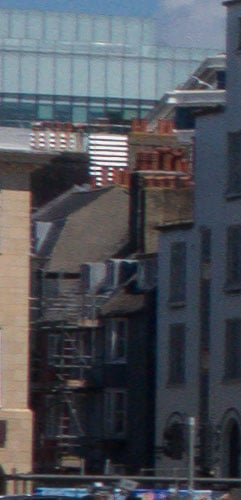 | 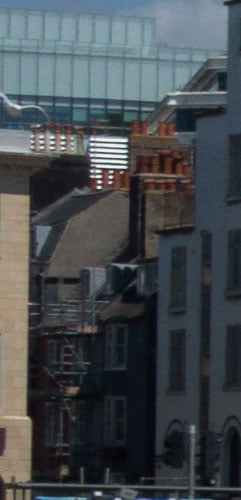 | 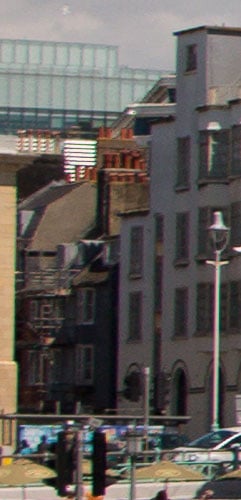 | ||
f4, 160 ISO | f4, 125 ISO | f4, 100 ISO | ||
 |  |  | ||
f4, 160 ISO | f4, 125 ISO | f4, 100 ISO | ||
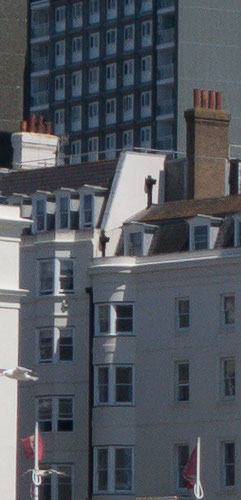 |  | 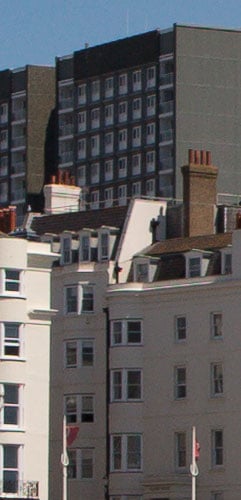 | ||
f4, 160 ISO | f4, 125 ISO | f4, 100 ISO | ||
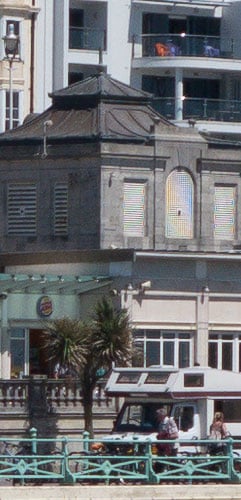 | 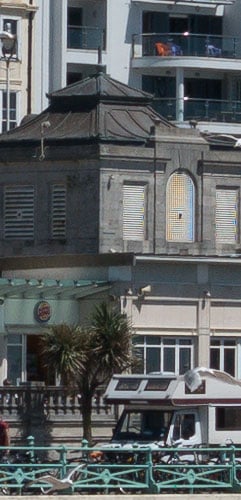 |  | ||
f4, 160 ISO | f4, 125 ISO | f4, 100 ISO | ||
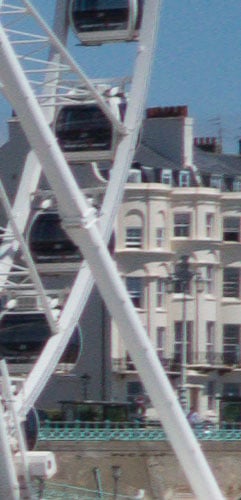 | 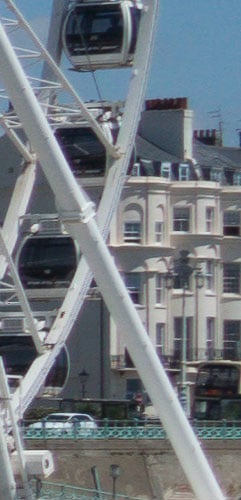 | 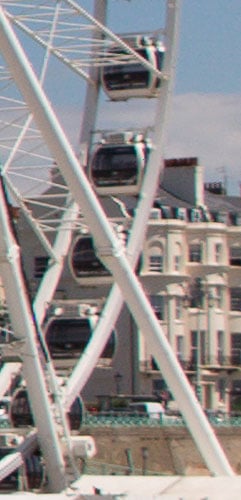 | ||
f4, 160 ISO | f4, 125 ISO | f4, 100 ISO |
Canon G1 X II vs Sony RX100 II vs RX100 III Noise RAW

To compare RAW noise levels under real-life conditions, I shot this scene with the Canon PowerShot G1 X Mark II, and the Sony Cyber-shot RX100 Mark II and III, within a few moments of each other using their RAW modes at each of their ISO sensitivity settings. I matched the field of view on each camera and set them at an aperture previously determined to deliver the sharpest results.
I tested all three cameras at each of their apertures and found f4 to be a common sweetspot, so that’s what I set each of them to in Aperture Priority. I then shot this scene at each of their sensitivities, noting identical shutter speeds for identical ISOs, so what you’re looking at below are entirely comparable results.
On this page I’m comparing their noise levels on RAW files processed in Adobe Camera RAW with identical settings: 50 / 0.5 / 36 / 10 for the unsharp mask, 3650K / +15 for the White Balance, all noise reduction turned-off and all lens corrections disabled. The higher than normal degree of sharpening and zero NR brings out all the detail but also any undesirable artefacts, revealing what data you have to work with when processing by hand.
The crops as always are taken from the area marked by the red rectangle in the thumbnail above left and presented here at 100%. The two Sony cameras show the same image area due to the same sensor resolution, but the Canon G1 X II shows a greater area due to its lower sensor resolution. I’ve pictured the crops in columns, from left to right, Sony RX100 Mark II, Sony RX100 Mark III and Canon G1 X Mark II.
Starting with the two Sonys, I’d say despite a minor difference at the lowest ISO here, they share essentially the same quality – as indeed you might expect given the same sensor and a crop from an area where the two lenses should perform equally well.
The really interesting comparison is between the 1in / 20 Megapixel sensor of the Sonys versus the 1.5in / 12.8 megapixel sensor of the Canon. As you’d expect the Canon keeps noise levels lower than the two Sonys thanks to its bigger sensor and lower resolution. The Canon G1 X II is still very clean at 800 ISO, and even at 1600 ISO when the first minor sprinklings of noise appear, it remains around two stops ahead of its rivals here. Between 3200 ISO and 12800 ISO I’d say the gap narrows to around one stop, but it remains an advantage to the Canon, even when you’ve taken the benefit of down-sampling of the Sony images to 12 Megapixels into consideration.
So the non-surprise here is the Canon G1 X II enjoys lower noise mostly at mid to high sensitivities when the same ISO values are selected – it does after all have a bigger sensor with fewer pixels packed into it. But remember to take the lens aperture into consideration as it will influence which ISO you’re using under certain conditions. When both cameras are zoomed-out to deliver a 24mm equivalent fields of view, there’s only one quarter of a stop between their lenses, so they’d both be using much the same ISOs – and in this situation the Canon would deliver better quality. But zoom their lenses to 70mm equivalent and the Sony RX100 III lens becomes one stop brighter than the Canon, allowing it to deploy a sensitivity of half the value. This narrows the quality gap between them, so if you’re shooting at long focal lengths there may not be as big a difference between them as originally thought. So think carefully at what focal lengths you’re most likely to be using each camera at under dark conditions.
Next check out my Canon G1 X II sample images or skip to my final verdict.
Noise results coming soon…
Canon G1 X II vs Sony RX100 II vs RX100 III Noise JPEG

To compare noise levels under real-life conditions, I shot this scene with the Canon PowerShot G1 X Mark II, and the Sony Cyber-shot RX100 Mark II and III, within a few moments of each other using their best quality JPEG settings at each of their ISO sensitivity settings. I matched the field of view on each camera and set them at an aperture previously determined to deliver the sharpest results.
I tested all three cameras at each of their apertures and found f4 to be a common sweetspot, so that’s what I set each of them to in Aperture Priority. I then shot this scene at each of their sensitivities, noting identical shutter speeds for identical ISOs, so what you’re looking at below are entirely comparable results.
On this page I’m comparing their noise levels on JPEGs processed with the in-camera defaults, with the exception of disabling any contrast enhancement as this can increase artefacts at high ISOs. The crops as always are taken from the area marked by the red rectangle in the thumbnail above left and presented here at 100%. The two Sony cameras show the same image area due to the same sensor resolution, but the Canon G1 X II shows a greater area due to its lower sensor resolution. I’ve pictured the crops in columns, from left to right, Sony RX100 Mark II, Sony RX100 Mark III and Canon G1 X Mark II.
One first thing to note: the older RX100 Mark II has a lowest base sensitivity of 160 ISO compared to 125 on the newer Mark III. Both cameras share extended low options, but it’s interesting to see how the Mark III claims a lower base despite the same sensor. Either way, it’s all academic at 200 ISO and above.
I shot this scene of the guitars in high hopes it’d reveal some key differences between their noise levels and processing styles, but the decorative colours and patterns ended up hiding more than they revealed, at least for the JPEG comparison on this page.
Comparing the two Sonys first, they share very similar styles and degrees of detail up to 1600 ISO. There’s crisp details, especially in the reflections up to 400 ISO that begins to soften at 800 ISO and above. By the time you reach 1600 and 3200 ISO, much of the fine detail and markings has disappeared, although the NR does a good job at hiding any issues – it’s only when you scroll back up to the lower ISOs that you notice what’s actually gone. At the highest sensitivities the newer RX100 Mark III looks to be a little less noise averse, allowing greater textures to creep-in with the resulting benefit of slightly greater detail. But ultimately I’m ranking this one as a draw in terms of JPEGs using the in-camera defaults.
Moving onto the RX100 Mark III versus the Canon G1 X Mark II, the latter does indeed enjoy slightly crisper details and less noise, most noticeable between 400 and 1600 ISO, although beyond here they’re all suffering. Interestingly though the Canon misses out on the very fine line texture on the surface of the guitar that’s just about resolved by the two Sonys at their lowest respective sensitivities, again confirming greater real-life detail by the RX100 models at the lowest ISOs.
What you’re really seeing here though are their respective noise reduction strategies. What happens when there’s no noise reduction at all? You can find out in my Canon G1 X II RAW noise results, or if you’ve seen enough, skip to my Canon G1 X II sample images or final verdict.
Results being reformatted, coming soon!




